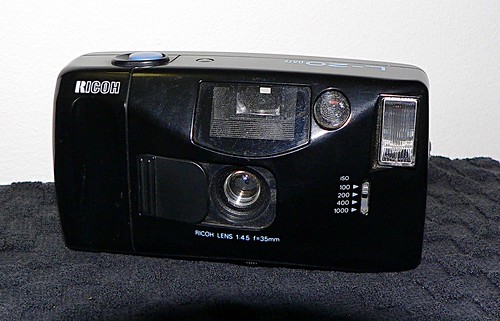Difference between revisions of "Ricoh L-20"
m |
(added yf20 super photo) |
||
| Line 1: | Line 1: | ||
| − | + | {|class=floatright | |
| + | | | ||
{{Flickr_image | {{Flickr_image | ||
|image_source= http://www.flickr.com/photos/russellmcneil/8518195814/in/pool-camerawiki/ | |image_source= http://www.flickr.com/photos/russellmcneil/8518195814/in/pool-camerawiki/ | ||
| Line 8: | Line 9: | ||
|image_rights= non-commercial | |image_rights= non-commercial | ||
}} | }} | ||
| − | + | |- | |
| + | | | ||
| + | {{Flickr_image | ||
| + | |image_source= http://www.flickr.com/photos/33dollars/6822522074/in/pool-camerawiki/ | ||
| + | |image= http://farm8.staticflickr.com/7178/6822522074_ab5b8d6ca9.jpg | ||
| + | |image_align= right | ||
| + | |image_text= YF-20 Super | ||
| + | |image_by= 33dollars | ||
| + | |image_rights= wp | ||
| + | }} | ||
| + | |} | ||
The [[Ricoh L-20|L-20]] is a [[point and shoot|point-and-shoot]] camera for [[35mm film]], introduced by Japanese manufacturer [[Ricoh]] in 1989. It is also known as the '''YF-20 Super''' or the '''One Take Easy II'''. This camera was designed primarily to meet the demand from the markets in developing countries; people especially in Asia had a preference for a camera of not-too-small body size, AA-type power source rather than Lithium type, manual film speed rating etc. | The [[Ricoh L-20|L-20]] is a [[point and shoot|point-and-shoot]] camera for [[35mm film]], introduced by Japanese manufacturer [[Ricoh]] in 1989. It is also known as the '''YF-20 Super''' or the '''One Take Easy II'''. This camera was designed primarily to meet the demand from the markets in developing countries; people especially in Asia had a preference for a camera of not-too-small body size, AA-type power source rather than Lithium type, manual film speed rating etc. | ||
Revision as of 18:49, 12 July 2014
| ||
|
The L-20 is a point-and-shoot camera for 35mm film, introduced by Japanese manufacturer Ricoh in 1989. It is also known as the YF-20 Super or the One Take Easy II. This camera was designed primarily to meet the demand from the markets in developing countries; people especially in Asia had a preference for a camera of not-too-small body size, AA-type power source rather than Lithium type, manual film speed rating etc.
Although this camera is categorized as a fixed-focus point-and-shoot, it can focus on a distant subject by sliding the tiny lever located below the lens.
A model with a date back was also available, and it was sold as the L-20 Date or the YF-20 Super Date.
Successor Model: Ricoh LX-22 (an updated model with the addition of self-timer and auto-flash)
Contents
Specifications
- Release Date: September 1989
- Camera Type: 35mm film lens shutter camera
- Lens: Ricoh Lens 35mm f/4.5, 3 elements in 3 groups
- Focus: fixed-focus, with infinity setting facility
- Shutter: mechanical, 1/125s (fixed speed)
- Exposure Control: fixed exposure[1]
- Viewfinder: reverse Galilean type, 0.52X, 80% field of view
- Film Speed Range: manual setting, ISO 100 / 200 / 400 / 1000
- Built-in Flash: activated by sliding flash switch, low light warning LED
- Flash Range: 1.2 m ~ 3.1 m (ISO 100)
- Other Features: automatic film loading, automatic film advance, automatic film rewind
- Power Source: one 3V Lithium battery (CR-123A) or two AA-type batteries (alkaline or manganese)
- Dimensions: 132 mm X 68 mm X 50 mm
- Weight: 220 g (without batteries)
Model Variation
| Release Date | Model Name | Updates |
|---|---|---|
| 1987.2 | YF-20 (Myport Ami) | Predecessor to the series, Rikenon 35mm f/4 Lens |
| 1989.9 | L-20 (YF-20 Super / One Take Easy II) | Ricoh 35mm f/4.5 Lens, Large body |
| 1991.7 | Auto 35 (Boots C35FF) | (Downgraded model, limited ISO choice, no infinity focus) |
| 1992.3 | LX-22 (LX-22S / XOBBOX) | New design, Self-timer, Auto-activating flash |
| 1993.5 | YF-20X | New design |
| 1997.12 | YF20-E | Smaller body, New design, DX-coding |
| YF-20N | Ricoh 34mm f/4.5 Lens, Smaller body, New design, DX-coding |
Notes
- ↑ A particular aperture is selected according to the film speed regardless of the light condition
Links
- L-20 on Ricoh Official Website, Camera List
- Ricoh L-20 manual on Michael Butkus' Camera Manual Library

